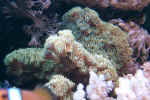 This
is a Turbinaria sp. coral, as know as Pagoda coral. It will do well under both
Power Compact and Metal Halide lighting. It should receive moderate current,
enough to make the polyps sway slightly. Growth and polyp extension will
improve with frequent feedings of zooplankton, small pieces of shrimp, or even
marine flake food. It is a non aggressive coral so it is easily placed in the
reef. Do not place it near mushroom polyps. They will cause severe tissue
damage to this coral.
This
is a Turbinaria sp. coral, as know as Pagoda coral. It will do well under both
Power Compact and Metal Halide lighting. It should receive moderate current,
enough to make the polyps sway slightly. Growth and polyp extension will
improve with frequent feedings of zooplankton, small pieces of shrimp, or even
marine flake food. It is a non aggressive coral so it is easily placed in the
reef. Do not place it near mushroom polyps. They will cause severe tissue
damage to this coral.
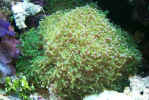 This
is a Euphyllia divisa, or Frogspawn coral. This species does better under
higher lighting conditions like that of Metal Halide and higher wattage
amounts of Power Compact lights. It prefers low to moderate current. Too much
current will cause the polyps to remain somewhat withdrawn. This coral is a
very aggressive feeder so it needs to feed frequently with small pieces of
shrimp, fish, scallops, squid. Make sure to give this coral room to spread. It
is very aggressive and will sting nearby corals, especially other stony
corals.
This
is a Euphyllia divisa, or Frogspawn coral. This species does better under
higher lighting conditions like that of Metal Halide and higher wattage
amounts of Power Compact lights. It prefers low to moderate current. Too much
current will cause the polyps to remain somewhat withdrawn. This coral is a
very aggressive feeder so it needs to feed frequently with small pieces of
shrimp, fish, scallops, squid. Make sure to give this coral room to spread. It
is very aggressive and will sting nearby corals, especially other stony
corals.
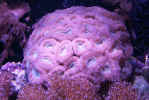 This
Caulastrea furcata, or candy coral, is a good sp. to introduce oneself to
stony corals. Although it is rather hardy, finding a healthy specimen can be a
problem. I've noticed that many of these corals have receded tissue at the
store. Make sure to check for this before you take one home. This species
fairs well under most lighting conditions and prefers low to moderate current.
This coral also enjoys to fed like the Frogspawn. Candy coral is relatively
harmless to it's neighbors.
This
Caulastrea furcata, or candy coral, is a good sp. to introduce oneself to
stony corals. Although it is rather hardy, finding a healthy specimen can be a
problem. I've noticed that many of these corals have receded tissue at the
store. Make sure to check for this before you take one home. This species
fairs well under most lighting conditions and prefers low to moderate current.
This coral also enjoys to fed like the Frogspawn. Candy coral is relatively
harmless to it's neighbors.
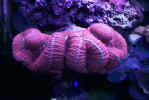 Red
Lobophyllia sp., a.k.a. Red Open brain coral is one of my favorites. It's care
is very similar to that of the Candy coral. Because it's polyps are very
large, you can feed this coral large pieces of shrimp, crab, and whole
scallops.
Red
Lobophyllia sp., a.k.a. Red Open brain coral is one of my favorites. It's care
is very similar to that of the Candy coral. Because it's polyps are very
large, you can feed this coral large pieces of shrimp, crab, and whole
scallops.
 This
Pocillipora sp. coral is a small polyped stony coral (SPS). It actually
hitchhiked it's way into my reef attached to the foot of a Lobophytum sp.
leather coral that I have. This is the only SPS coral that I have. It's seems to
be very hardy. It was originally only one branch and in about it's grown to the
size pictured in about 1 year. I've moved to many different areas within the
reef during the year and it displayed excellent polyp extension in all areas.
This
Pocillipora sp. coral is a small polyped stony coral (SPS). It actually
hitchhiked it's way into my reef attached to the foot of a Lobophytum sp.
leather coral that I have. This is the only SPS coral that I have. It's seems to
be very hardy. It was originally only one branch and in about it's grown to the
size pictured in about 1 year. I've moved to many different areas within the
reef during the year and it displayed excellent polyp extension in all areas.
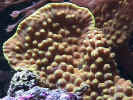 This
is another Turbinaria sp., generally referred to as a Yellow Cup coral. Follow
the same general guidelines as for the Pagoda coral. The polyps of this species
are smaller than the Pagoda so feedings will be limited to zooplankton and brine
shrimp.
This
is another Turbinaria sp., generally referred to as a Yellow Cup coral. Follow
the same general guidelines as for the Pagoda coral. The polyps of this species
are smaller than the Pagoda so feedings will be limited to zooplankton and brine
shrimp.

![]()